![]()
![]()
![]()
![]()
![]()
![]()
memāra
one’s biological mother. This is more of a technical term and is not in wide usage. In the picture below, the green circle is the purple square’s memāra.
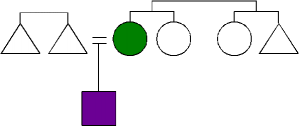
![]()
![]()
![]()
![]()
![]()
![]()
memāra
one’s biological mother. This is more of a technical term and is not in wide usage. In the picture below, the green circle is the purple square’s memāra.

![]()
![]()
![]()
![]()
![]()
![]()
mapāra
one’s mother, aunt, foster-mother, one’s mother’s sister, any of one’s mother’s female relatives of the same generation. In the picture below, the purple square’s mapāri are designated by the green circles.

![]()
![]()
![]()
![]()
![]()
![]()
![]()
maxāntie
one’s lover, spouse, one’s special companion, perhaps a close sister or brother or lover, personally chosen kin of the same generation. One’s maxāntie does not necessarily start out as kin, though they can, but is otherwise considered to be one’s kin. They are not necessarily part of one’s clan, however, as that is governed by other rules.
![]()
![]()
![]()
![]()
makāe
one’s sister, brother, cousin, sibling or cousin of the opposite gender as oneself. [Plural makāji.]
So, if one is female (purple circle):
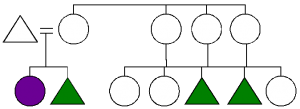
then all the green triangles are one’s makāji. Likewise, if one is male (purple triangle):

then all the green circles are one’s makāji.
![]()
![]()
![]()
![]()
matiē
one’s sister, brother, cousin, sibling or cousin of the same gender as oneself. [Plural matīji.]
So, if one is female (purple circle):
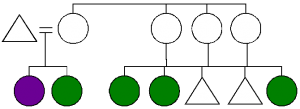
then all the green circles are one’s matīji. Likewise, if one is male (purple triangle):
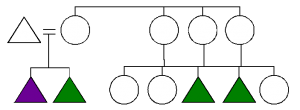
then all the green triangles are one’s matīji.
![]()
![]()
![]()
![]()
![]()
![]()
![]()
![]()
![]()
maþūskīri
The Kēleni see one’s kin as threads in a woven cloth. One’s makīri are the up and down threads (warp) and one’s maþūskīri are the side to side threads (weft). [See Wikipedia article on Weaving for more information on weaving.]
At it’s narrowest, maþūskīri means one’s father’s matrilineal kin. The meaning has expanded to include close friends, colleagues one interacts with every day, and other people one can reliably ask a favor of.
![]()
![]()
![]()
![]()
![]()
![]()
makīri
one’s kin, the people to whom one is related to by matrilineal descent. In the picture below, the two colors are two separate clans, and so two separate sets of makīri.
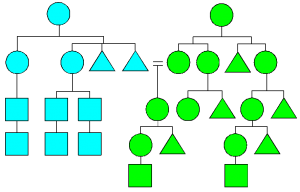
![]()
![]()
![]()
![]()
sūxa
one’s anus or asshole.
Turning this body part into an animate noun leads to two different terms – one insulting and one affectionate. The insulting term is mūxa which describes a person who says things to deliberately cause harm. These things don’t have to be lies, they just have to be intended to cause harm. So a malicious person.
The other term mūxisse is an informal term using an old diminutive and refers to people (or other dependents) one has to continually clean up after. The term expresses both affection and aggravation.
![]()
![]()
![]()
![]()
saŋē
one’s face, the front half of one’s head
![]()
![]()
![]()
![]()
maŋē
an informal word for person.
Actually, one can take nearly any body part and turn it into an animate noun meaning person. Turning a body part into a person implies that the person is being thought of as consisting primarily of that body part. So one could speak of eyes or ears as people when thinking of witnesses, or bellies as people when planning for how much food to prepare, or hands as people when figuring out how much labor is needed. manārme and maŋē are the most common body parts to be turned into animate nouns.
![]()
![]()
![]()
![]()
![]()
![]()
![]()
sanārme
one’s physical body. This is an obligatorily possessed noun. The prefix sa- indicates third person, any number. First person prefix is le-, second person is ri-.
![]()
![]()
![]()
![]()
![]()
![]()
![]()
manārme
This is an informal word for person.
![]()
![]()
![]()
![]()
![]()
![]()
![]()
annārme
As a stative noun, this means having a body. It generally only occurs in the phrase
ānen annārme wā
‘without a body, disembodied.’